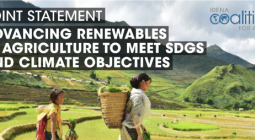An environmental sociologist explains how permaculture offers a path to climate justice

Big farming is both a victim of climate change and a contributor. Droughts, floods and soil degradation threaten crop yields. But agriculture produces nearly one-quarter of global greenhouse gas emissions.
A potential antidote to harmful monocultures is a form of community farming invented back in the 1970s: permaculture. Permaculture is not just about farming; it incorporates economic and social principles.
I am an environmental sociologist, and I have witnessed permaculture working in two urban farming communities. I study ways that environmental justice, global development and social equity affect climate change.
Permaculture’s three main tenets – caring for the Earth, caring for the people and sharing the surplus – offer a potential path toward climate justice, which is a response to well-researched phenomena that climate change disproportionately harms underprivileged groups in economic, public health and other ways, and solutions to climate change should include adaptation strategies designed specifically for underprivileged groups.
I spent time at two communities in the Pacific Northwest and in Cuba during the fieldwork for my book “Surviving Collapse.” I witnessed how the communities worked to cut emissions and adapt to climate change in two ways: with egalitarian social organization and regenerative farming techniques.

Permaculture was born in Australia
In the 1970s, two Australian naturalists, Bill Mollison and David Holmgren, invented permaculture, a method of growing that considers the natural ecosystem and the community. They wanted to change agriculture’s unsustainable practices, like the heavy use of synthetic fertilizers and pesticides.
Mollison and Holmgren borrowed ideas and techniques from the knowledge and practices of Indigenous and traditional peoples, as well as the “do-nothing” farming methods of Japanese farmer and philosopher Masanobu Fukuoka. Today permaculture is an international movement that, although understudied, shows great promise.
Permaculture aims to care for the Earth by emulating how healthy natural ecosystems function rather than trying to fight or control nature. Its methods are regenerative, meaning that they maintain healthy, nutrient-rich soils, minimize waste, conserve water and protect wildlife habitat. Permaculture often produces crops that are more nutritious than those from industrial farms and, in some cases, yields greater harvests.
Permaculture differs from organic farming in that organic is a legal designation about regulating genetically modified organisms and synthetic fertilizers and pesticides, whereas regenerative agriculture is more concerned with ecosystem and soil health. Both permaculture and organic methods sometimes manage fertilizers or pests in similar ways. However, as Holmgren has emphasized “people, their buildings and the ways they organize themselves are central to permaculture.”
Permaculture in the Pacific Northwest
Two of the communities I observed practiced permaculture’s principles of caring for the Earth and people and sharing the surplus.
I call one place I studied in 2007 Asaṅga – the name is made up to give my subjects confidentiality. It’s a 1-acre, 30-person “ecovillage,” or environmental intentional community, in the Pacific Northwest – the agricultural efforts involve a variety of permaculture practices to maintain the soil, ranging from composting food scraps to fertilizing gardens with chicken manure.
To avoid synthetic fertilizers and pesticides, the ecovillagers use techniques like “polyculture” – mimicking the diversity of natural ecosystems by simultaneously growing several different crops in the same place. For instance, they plant food crops with cover crops such as lentils, peas, beans and soybeans that increase the soil’s natural fertility, manage erosion and help retain soil moisture.
Asaṅga residents practice ecological pest management, in which they proactively prevent pests rather than attempt to eradicate them after they’ve arrived. One way they do this is through “companion planting” – growing food crops together with noncompetitive, pest-repelling plant species like marigold, mint or sage.
Asaṅga irrigates crops with captured rainwater and filters wastewater from low-impact activities like dishwashing or bathing for its decorative fountain in the village center.
Permaculture in Cuba
The farmers at a 27-acre urban farm in Havana, Cuba, that I call el Organopónico – again, a made-up name – share similar concerns and practices. The farm’s roughly 200 cooperative members manage 11 areas, such as livestock, fields and nursery, so that each contributes to another.
They save manure from the bulls in the livestock area – which are employed to transport heavy equipment – to feed the worms at the vermiculture station. The worms consume the manure and expel their own waste, or humus, which is combined with compost and rice shells to make soil and fertilizer for trays of tomatoes, lettuce, onions, garlic, guava, mint, and chamomile seedlings in the plant nursery.
Very little is wasted at el Organopónico. Even overripe crops are turned into condiments or are composted. The farmers also recycle potential waste by cleaning and reusing soda bottles for value-added products on the farm, such as tomato paste.
Farms run by community consensus
The permaculture principle of caring for the people refers to making sure people can meet basic needs for healthy food and good homes. It also sets expectations for the ways communities organize themselves to make decisions, manage conflict and achieve larger goals like providing education.
At Asaṅga, people pay rent to live at the community. Residents together decide community issues, such as what to do with the geese on the property and where to store the compost. At bimonthly meetings, ecovillagers decide most questions by consensus.
El Organopónico is led by a president who was voted into leadership. At the farm, they meet monthly, and everyone votes on new proposals, which pass by simple majority. This farm is a workers’ cooperative. The members own the machinery, inputs like seeds or fertilizers and the produce they grow. They pay the government a subsidized rent for the land.
Sharing surplus can slow overconsumption
Human populations are consuming far more in a given year than the Earth can replenish and creating waste much faster than the Earth can assimilate it. This is a global problem, but the worst offenders are affluent people of the West.
Sharing surplus is a way of limiting consumption. Asaṅga residents share in many ways. Community meetings are potlucks where villagers share food from their gardens. One community member shared bread from a local bakery that gave away leftovers. Ecovillagers share tools, knowledge and other resources.
Farmers at el Organopónico share surplus through wages. During my fieldwork, the farmers earned a decent wage by Cuban standards, and wages at the farm were capped and calculated based on years employed at the farm. Workers began at a minimum salary and earned a raise every five years. In times of surplus, profits were evenly distributed.
Although my research focused on only two small communities, I believe the principles of permaculture offer an important model because they address both the environmental and social challenges posed by climate change.
Permaculture holds powerful lessons that could guide many countries to save resources and cut emissions, thus finding a balance between production and consumption.
17 November 2021
THE CONVERSATION




